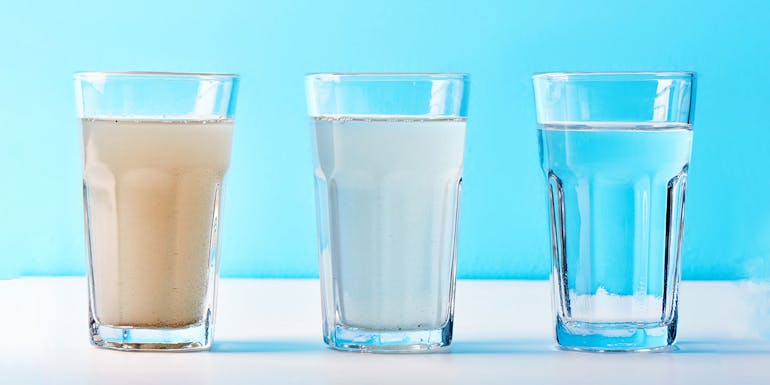
Lea Bieri, 29 February 2024
Virus protection
Hygienic humidifier not bacteria distributor
Relative humidity of 40–60% is the optimal level for a healthy indoor climate. You can measure this using a hygrometer. If the humidity drops below 40%, then it’s time to get a humidifier. Reports on humidification often seem to contain negative comments about humidifiers being unhygienic or at worst encouraging disease. This can lead to uncertainties. Let us put the matter straight.
Read on to find out:
- Humidifier and bacteria
- Limescale deposits and dirt in your humidifier
- Distilled water and water from a water softener
- Regular cleaning for optimum hygiene
- Cleaning and storage after the season
- Accessories for keeping your humidifier hygienic
Humidifier and bacteria
Basically, humidifiers are not distributors of bacteria. Humidifiers are always hygienic as long as they are correctly maintained. Dirt in the appliance either comes from the water used (e.g. not drinking water quality) or from the indoor air. Impurities such as house dust, animal hair, pollen and mites only enter the appliance from outside. If the water contaminated with this dirt is left in the humidifier for a long period of time while it is not in use, it can become a breeding ground for bacteria and microbes.
To keep your humidifier hygienic, we recommend that you clean and descale it thoroughly on a regular basis and fill it up with fresh, cold tap water every day. You should also make sure to replace accessories in your appliance regularly in order to inhibit the growth of bacteria and germs and maintain a high level of efficiency.
Important note: look inside your appliance regularly in order to find out whether it needs cleaning or descaling. Limescale occurs in the form of white deposits. If the water base of your humidifier is covered with a white layer of limescale, you should clean your appliance.
Our tips at a glance
- Fill up with fresh, cold drinking water every day
- Clean and descale thoroughly on a regular basis
- Use helpful accessories
The individual factors which are important for keeping your humidifier hygienic are explained in detail below.
Limescale deposits and dirt in your humidifier
Water can form limescale deposits on any type of surface. If you miss a drop of water when cleaning your bathroom or kitchen, it will leave behind a mark as soon as it dries: in the form of a white speck of limescale. These deposits are a rich breeding ground for micro-organisms such as bacteria or fungi, for example. Bacteria and algae can quickly multiply in standing water in particular. Just leave a used drinking water glass for a week and see what happens to the water left in it. You definitely wouldn’t want to drink the water at the end of the week.
It’s the same with the water in a humidifier. As long as the appliance is being used and filled with fresh water, it will be difficult for micro-organisms to establish themselves. However, if water is left in the humidifier when it is not being used, this can lead to the growth of microbes.
Limescale deposits are easy to prevent. Any appliance which uses water should be filled with fresh water on a daily basis. Limescale deposits can be reduced to a minimum if the appliance is descaled regularly according to the water hardness in your area. So, the appliance will remain hygienic while it is being used continuously. If you do not use your appliance every day, it is important to empty it before turning it off and if it is not going to be used for a long period of time, you should descale it and dry it thoroughly. So, the next time you come to use your appliance, it will be clean.
Distilled water and water from a water softener
Distilled water can be used in order to avoid stains caused by water of insufficient quality and limescale deposits caused by hard water. As it is expensive to do this in most countries, we recommend using a 50:50 mixture of tap water and distilled water. In this YouTube video, we explain in detail how using this mixture works. As there is less calcium in the mixture of tap water and distilled water, limescale deposits will be reduced.
Important note: the use of distilled water cannot replace regular cleaning of your humidifier!
If you use water from a water softener, before purchasing a humidifier you should find out from the manufacturer the most suitable appliance for you to use. It can be identified by the property management whether a water softener is installed. Depending on the amount of salt used, water from the water softener contains significantly less limescale. The salt content changes the composition of the water, which reduces the formation of limescale. The more salt is used, the lower the hardness of the water and the less limescale the water contains. However, the high quantity of salt in the water also leads to the formation of deposits in the humidifier – salt rather than limescale deposits – which can be a breeding ground for micro-organisms just like limescale. So, the same applies here too: look inside your appliance from time to time and carry out cleaning and descaling on a regular basis.
Regular cleaning for a clean and hygienic humidifier
The be-all and end-all for every humidifier is for it to be cleaned and for any limescale to be removed correctly and thoroughly on a regular basis. It may sound like a lot of work but it’s not. You should clean your humidifier once a week, regardless of the size of the room in which it is being used. Irrespective of the manufacturer or type of humidification system – hot vapour or cold mist – that you have, every appliance requires attention if it is to remain germ-free. Let's consider the water glass once more: see what happens if you leave some water in the bottom of the glass and put it to one side. After a few days, you would hardly use the dirty glass again: instead, you would wash the glass before filling it with fresh water.
Besides the appliance-specific cleaning instructions, manufacturers also provide recommendations on how often an appliance should be cleaned and the best agents to use for the job. In principle, we recommend that all humidifiers should be cleaned once a week and that descaling should be carried out regularly according to the hardness of the water in your area. And look inside your appliance on a regular basis so that any limescale deposits that may have formed can be found early and removed.
Cleaning and storage of your humidifier after the season
Cleaning a humidifier is not only extremely important during normal operation but even more important at the end of the season before the humidifier is put away. It is particularly important to make sure that all the parts are clean and dry before the humidifier is packed up and stored. This prevents mould growth caused by residual moisture in the appliance and the build-up of bacteria. We also recommend that cleaning is carried out before an appliance is used again after being turned off for a long period of time.
Stowing the humidifier: the right way to do it
- Wait for the right time: This depends on the weather and the humidity in your home. As winter slowly recedes and the days get warmer again, indoor humidity levels usually rise. If there are no more cold days in sight, you can switch off the humidifier, empty it from any remaining water and use a hygrometer to monitor the humidity for a few days to make sure it doesn't drop too low before storing the appliance away completely. If the relative indoor humidity in spring constantly stays above 45 per cent, most people do not need a humidifier anymore.
- Clean and descale your humidifier: Proceed as described above or refer to the operating instructions for your humidifier for precise instructions. Make absolutely sure that all components are completely dry before packing. Discard of used accessories such as anticalc cartridge and Water Cube. Do not store a used anticalc cartridge as the resin inside is saturated with water, which provides a breeding ground for microbial and mould growth.
- Replace the humidifier accessories: At the end of the season, you should also replace the accessories such as filters, Water Cube and anticalc cartridge. Leave the new accessories in their original packaging and pack them together with your humidifier. This will save you the hassle of having to collect all the components when you put the humidifier back into operation.
- Pack your humidifier: it is best to pack your humidifier in its original packaging. If you no longer have this to hand, you can store the humidifier in a plastic bag and a suitable cardboard box. It is also important that you store the humidifier in a dry place.
Additional tip (currently only available in Switzerland for Stadler Form products): If you don't feel like thoroughly cleaning and descaling your humidifier yourself before storing it away, you can benefit from our all-round carefree service. Our service team will clean your humidifier and check all functions. You will also receive new filters, a new Water Cube, a bottle of cleaner & descaler and a one-year guarantee on the service carried out.
Accessories for keeping your humidifier hygienic
In order to achieve better hygiene results and reduce limescale deposits, the accessories recommended by the manufacturer should be used. Most manufacturers provide recommendations for the service life of the appliance in each case. The guidelines for replacing accessories should be followed to make sure that your appliance remains hygienic. Various accessories – filters, anticalc cartridges or remedies for keeping your appliance fresh – will be required depending on the humidification technology that you are using. You can find more information on the various humidifier systems on our information page on humidifying the air.
Evaporators use one or more filters for the water evaporation process. We recommend changing the filters every 2 months in order to promote hygiene in your appliance. The filter exchange should be carried out during normal operation but also before putting the appliance away or before using it again after it has been turned off for a long period of time.
In addition, we recommend the use of the Water Cube or Hygiene Tabs for Stadler Form humidifiers and the anticalc cartridge for nebulisers and air washers (for the latter from a water hardness of over 21 °dH).
Watch our video to learn how to clean a humidifier quickly and easily.
Would you like to find out more about how a humidifier can help you feel better or what different humidifier systems are available? You can find more information on our information page about humidifying the air.
More about humidifying the air
If you have questions related to indoor room climate, please get in touch with us. Or subscribe to our newsletter to regularly get informed about current topics regarding indoor climate, experience reports or Stadler Form insights.







